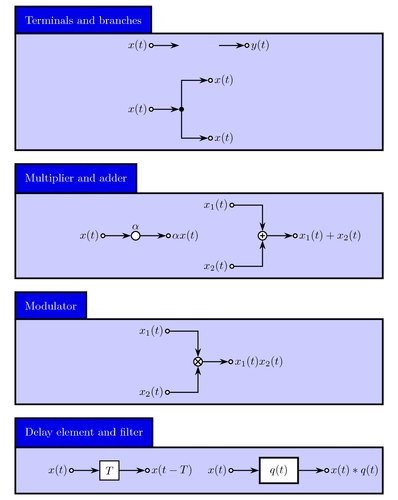The signalflow library by Karlheinz Ochs defines a variety of building blocks that can be used to draw signal flow diagrams. Examples are input and output nodes, multiplier and adder nodes, and filter and delay blocks. The library also extends the node placement syntax by adding the constructs right from=, above from= etc., that places nodes relative to node boundaries instead of node centers.
Files:
- Download the version of the signalflow library used in this example: signalflow.zip

Edit and compile if you like:
% Some basic examples for signal flow diagrams.
%
% Author: Dr. Karlheinz Ochs, Ruhr-University of Bochum, Germany
% Version: 0.1
% Date: 2007/01/05
\documentclass{article}
\usepackage{signalflowdiagram}
\usepackage[active,tightpage]{preview}
\setlength\PreviewBorder{5pt}%
\begin{document}
%
% Basic definitions of the symbols used in a signal flow diagram
%
\begin{preview}
% - input and output terminal
\begin{signalflow}{Terminals and branches}
% - input terminal
\begin{scope}
\node[input] (in) {$x(t)$};
\node[coordinate] (c) [right from=in] {};
% signal path
\path[r>] (in) -- (c);
\end{scope}
% - output terminal
\begin{scope}[xshift=3cm]
\node[output] (out) {$y(t)$};
\node[coordinate] (c) [left from=out] {};
% signal path
\path[r>] (c) -- (out);
\end{scope}
% - branching node
\begin{scope}[yshift=-2cm]
\node[input] (in) {$x(t)$};
\node[node] (nd) [right from=in] {};
\node[output] (out1) [above right from=nd] {$x(t)$};
\node[output] (out2) [below right from=nd] {$x(t)$};
% signal paths
\path[r>] (in) -- (nd);
\path[r>] (nd) |- (out1);
\path[r>] (nd) |- (out2);
\end{scope}
\end{signalflow}
\begin{signalflow}{Multiplier and adder}
% - multiplier
\begin{scope}
\node[input] (in) {$x(t)$};
\node[multiplier] (mul) [right from=in] {\nodepart{above}{$\alpha$}};
\node[output] (out) [right from=mul] {$\alpha x(t)$};
% signal paths
\path[r>] (in) -- (mul);
\path[r>] (mul) -- (out);
\end{scope}
% - adder
\begin{scope}[xshift=5cm]
\node[adder] (add) {};
\node[input] (in1) [above left from=add] {$x_1(t)$};
\node[input] (in2) [below left from=add] {$x_2(t)$};
\node[output] (out) [right from=add] {$x_1(t)+x_2(t)$};
% signal paths
\path[r>] (in1) -| (add);
\path[r>] (in2) -| (add);
\path[r>] (add) -- (out);
\end{scope}
\end{signalflow}
% - modulator
\begin{signalflow}{Modulator}
\node[modulator] (mul) {};
\node[input] (in1) [above left from=mul] {$x_1(t)$};
\node[input] (in2) [below left from=mul] {$x_2(t)$};
\node[output] (out) [right from=mul] {$x_1(t)x_2(t)$};
% signal paths
\path[r>] (in1) -| (mul);
\path[r>] (in2) -| (mul);
\path[r>] (mul) -- (out);
\end{signalflow}
\begin{signalflow}{Delay element and filter}
% - delay element
\begin{scope}
\node[input] (in) {$x(t)$};
\node[delay] (del) [right from=in] {$T$};
\node[output] (out) [right from=del] {$x(t-T)$};
% signal paths
\path[r>] (in) -- (del);
\path[r>] (del) -- (out);
\end{scope}
% - filter
\begin{scope}[xshift=5cm]
\node[input] (in) {$x(t)$};
\node[filter] (fil) [right from=in] {$q(t)$};
\node[output] (out) [right from=fil] {$x(t)\ast q(t)$};
% signal paths
\path[r>] (in) -- (fil);
\path[r>] (fil) -- (out);
\end{scope}
\end{signalflow}
\end{preview}
\end{document}
Click to download: signal-flow-building-blocks.tex • signal-flow-building-blocks.pdf
Open in Overleaf: signal-flow-building-blocks.tex


